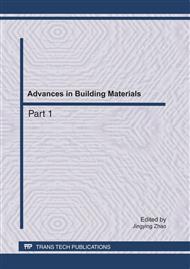[1]
MaranimiE. Creep behaviourofaweak rock: exprimental characterization [J]. Int. J. RockMech. &Min. Sc. i, 1999, 36 (3): 127-138.
Google Scholar
[2]
Cao Shugang, Bian Jin, LiPeng. Comparison research of creep experiments and the analysis of the theoreticalmodel of softrocks [J]. Journal ofChongqingUniversity, 2002, 25 (7): 96-98. (In Chinese).
Google Scholar
[3]
Zhongting Zhang, Hong Wang, Zhenyu Tao. Research on creep properties of rock[J]. Journal of Yangtze River Scientific Research Institute, 1996, 13(Supp): 1-5. (In Chinese).
Google Scholar
[4]
LIU Xiong. An introduction to rock rheology[M]. Beijing: Geological Publishing House, 1994. (in Chinese).
Google Scholar
[5]
XU Wei-ya, YANG Sheng-qi, YANG Song-lin, et al. Investigation on triaxial rheological mechanical properties of greenschist specimen(I): experimental results[J]. Rock and Soil Mechanics, 2005, 26(4): 531-537. (In Chinese).
Google Scholar
[6]
FAN Qingzhong,GAO Yanfa. Study of creep properties and nonlinear creep model of soft rock[J]. Chinese Journal of Rock Mechanics and Engineering, 2007, 26(2): 391–396. (In Chinese).
Google Scholar
[7]
Enrico Maranini, Tsutomu Yamaguchi. A non-associated viscoplastic model for the behaviour of granite in triaxial compression[J]. Mechanics of Materials, 2001, 33(5): 283-293.
DOI: 10.1016/s0167-6636(01)00052-7
Google Scholar
[8]
FAN Qiuyan, ZHU Weishen. Method of calculating optimum support for soft rock[J]. Chinese Journal of Geotechnical Engineering, 1997, 19(2): 77–82. (In Chinese).
Google Scholar
[9]
Akai K, Adachi T, Ando N. Existence of a unique stress-strain-time relation of clays[J]. Japanese Society of Soil Mechanics and Foundation Engrg, 1999, 15(1): 1~16.
DOI: 10.3208/sandf1972.15.1
Google Scholar
[10]
Liu Guangting, Hu Yu, Chen Fengq, i et a. l Rheological property of soft rock undermultiaxial compression and its effect on design of arch dam[J]. Chinese Journal of RockMechanics and Engineering, 2004, 23 (8): 1237-1241. (In Chinese).
Google Scholar
[11]
YANG Sheng-qi, XU Wei-ya, XIE Shou-yi, et al. Studies on triaxial rheological deformation and failure mechanism of hard rock in saturated state[J]. Chinese Journal of Geotechnical Engineering, 2006, 28(8): 962-969. (In Chinese).
Google Scholar
[12]
Specifications for rock tests in water conservancy and hydroelectric engineering SL264-2001. (In Chinese).
Google Scholar
[13]
LAMA R D, VUTUKURI V S. Handbook on mechanical properties of rocks,testing techniques and results(Vol. II) [M]. Clausthal:Trans. Tech. Publications,(1978).
Google Scholar
[14]
Yourong Liu, Huiming Tang. Rock mass mechanics[M]. Wuhan: China University of Geosciences Press, 1999. (In Chinese).
Google Scholar


